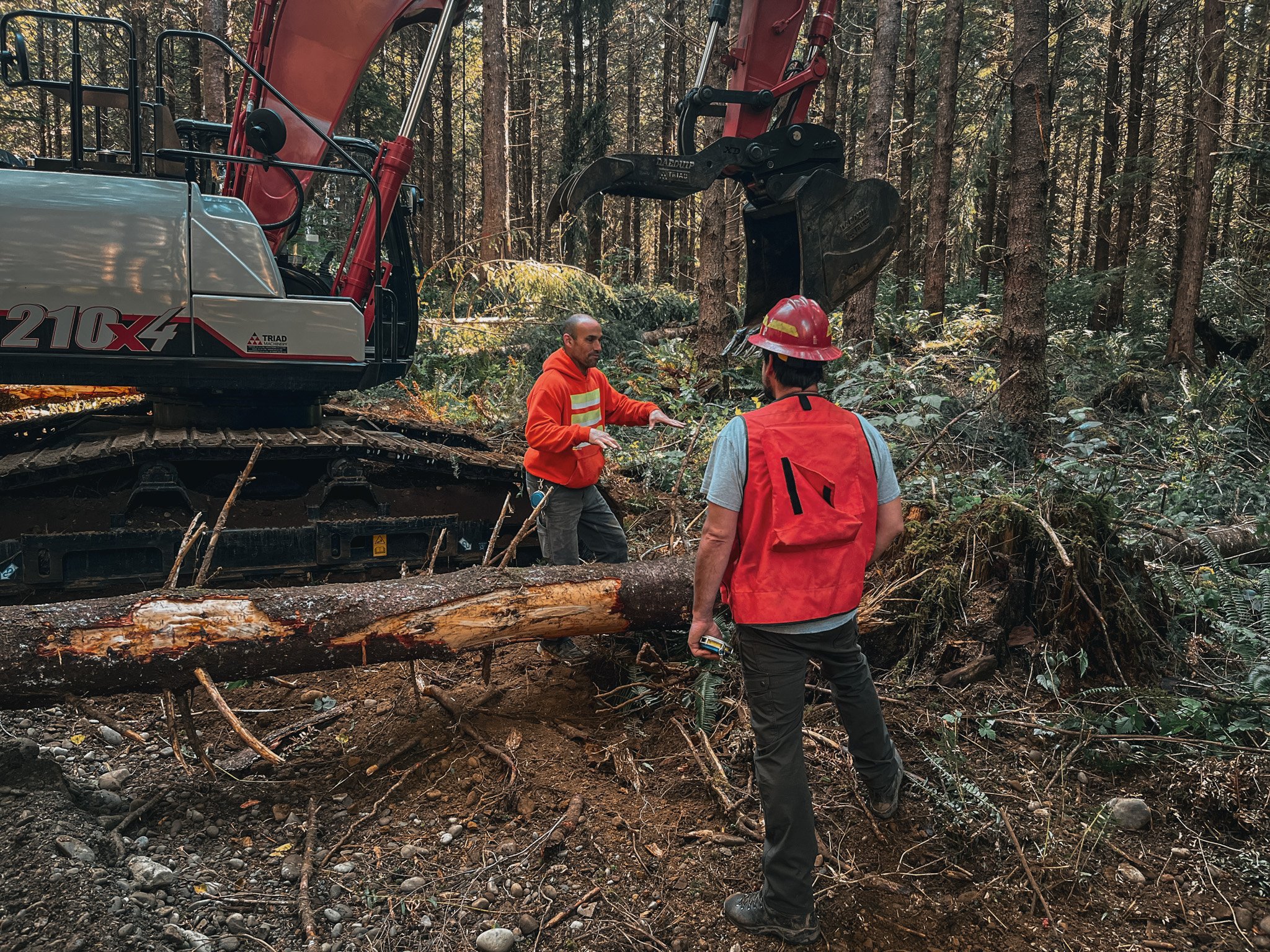by Leah Palmer, TNC Writer/Editor
Thriving salmon swim through healthy rivers. Healthy rivers are fed by pristine creeks. Balanced watersheds flow through dynamic forests—making forests pivotal places for salmon habitat restoration.
Justin Urresti, Conservation Forester, in the Clearwater Forest Reserve of Washington. Photo by Leah Palmer
Justin Urresti, Conservation Forester knows his work must take place in harmony with community members. This dynamic is especially true in the Clearwater Forest Reserve, acquired by The Nature Conservancy in 2011, as sometimes TNC appears to be opposed to industries that profit off the land. Justin’s forestry methods exist somewhere in the grey. He aims to both rehabilitate a forest that’s been logged since the late 1800s and support a local workforce within a changing economy.
Settled along the Clearwater River are generations of logging families who experience the forest as integral to their identity. So, when Justin began decommissioning a once legendary logging road, he was met with opposition from some community members. “If you just bring idealism here, you’re going to get that beat out of you. And once that’s gone, this is a tough place to live,” he says. But, he maintains, “someone has to speak for the land. Within the context of political narratives and ideologies, I was concerned about this road and it falling into the river.”
Justin Urresti (helmet) directs contractor, Jeremy, as they tip trees for engineered logjams. Photo by Leah Palmer.
Justin touts an extensive background in soil science and 30 years of experience in forests. He insists the West side of the Olympic Peninsula contains some of the “last great salmon and steelhead runs” in the lower 48.
They are unique in that they are not fed by hatcheries. They are not obstructed by dams. They are not degraded by development.
But, the greatest threat to these salmon runs are the impacts of logging. Today, TNC owns over 16,000 acres of land in the peninsula. The hope is to protect these vital corridors and tributaries from significant decline and the potential of salmon extension within our lifetime.
Justin says, “once [a forest] is clearcut it’s taken out of its natural regime. It can no longer be considered untouched and untrampled. A lot of people forget that part—that [TNC] didn’t inherit land that was majestic and unaffected. This land was clear cut multiple times. That’s our tableau, if you will. That’s what I’m given to paint on.”
With funds from the Salmon Recovery Funding Board (SRFB “Surf” Board), TNC is taking a multifaceted approach to managing these vital lands and waters. One approach is to tend to the existing logging infrastructure in the forest.
A dirt and gravel road sits 40 feet above Hunt Creek. Today it’s completely impassable by cars and trucks. Justin says, “There are essentially landslides that are happening here. This road, overtime, is falling directly into Hunt Creek.” It looks as if a massive bite was taken out of its’s side. Hunt Creek feeds into to Clearwater River, which eventually spills into the Pacific Ocean. Sediment from a failing road upstream can have significant impact on Salmon downstream.
With low-tech and inexpensive solutions, this road is now on a positive trajectory. Working alongside a local contractor, Justin placed a variety of natural materials along the road to avert water slow down erosive flooding. Rocks, straw, grass, and debris also work to filter sediment before it spills into the river.
Decommissioned logging road in the Clearwater Forest. Photo by Leah Palmer
He’s transformed the road into a wide foot-trail that leads to a campsite nearby the pristine Clearwater River—so locals can still access a favorite location for recreation. Occasionally, he monitors the progress of his work.
On the day of my visit, Justin was pleased to see the grass he planted weeks ago coming in strong. “Even though these are small things, I can make a difference here, here, here and here. And pretty soon, if you zoom out...” Justin trails off and lets me fill the pause silently. Impact. Then he goes on. “This is a very resilient place. But it can still break. The beauty of it being resilient is it can also recover.”
In his first eight months at TNC, Justin has begun a number of projects in the Clearwater Forest and a section of the Hoh Rainforest. Some of his methods include thinning acres of thick understory brush with man-power and saws.
Trees are tipped to strategically preserve their roots for engineered logjams to be placed in the nearby Clearwater River. Video by Leah Palmer
In other sections of the forest, he’s working with the Quinault Indian Nation to build engineered logjams (ELJ). They harvest trees from mature forest stands by tipping them over with heavy machinery. This preserves the trees’ root systems so they can be collected, bound together, and placed in the river to provide habitat and cover for fish. This process would naturally occur when mature trees fall into rivers, but some historic logging practices, specifically clearcutting right up to the river’s edge, has stunted these rhythms.
Justin plans to participate in what he playfully calls “hippie logging.” This approach sees some logging as a conservation method—cutting down select trees in order to allow space for others to grow bigger and stronger.
Speaking to the variety of his work, Justin reflects, “I find peace in variability. I’m cool with that.”

























